IFT VS TENS: Which Electrotherapy Modalities are Best for Pain Relief?
IFT vs TENS – Both are Pain reliever treatments that utilize electric currents for long-term intractable pain and post-operative and post-traumatic periods of acute pain/Chronic Pain.
The two procedures were proven harmless and effective alternatives to pharmacologic treatments to reduce pain. Equally, they have minimal side effects on patients and are mostly non-addictive. They can cause some adverse side effects by the irritations of the skin where the electrodes are placed. However, They are both convenient to use and easy to carry.
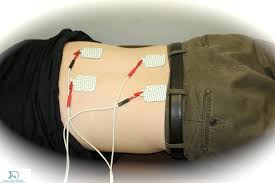
Table of Contents
# INTRODUCTION OF IFT:
The basic principle of Interferential Therapy (IFT) is to utilize the significant physiological effects of low-frequency (<250pps) electrical stimulation of nerves without the associated painful and somewhat unpleasant side effects sometimes associated with low-frequency stimulation.
Recently, numerous ‘portable’ interferential devices have become easily available. Despite their size, they are perfectly capable of delivering ‘proper’ interferential therapy, though some have limited functionality and the ability for the practitioner to ‘set’ all parameters.
INTRODUCTION OF TENS:
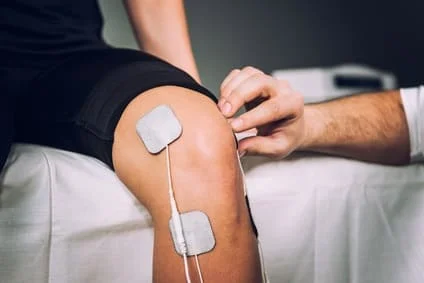
TENS is a method of electrical stimulation that primarily aims to provide a degree of symptomatic pain relief by exciting sensory nerves and thereby stimulating either the pain gate mechanism and/or the opioid system. The different methods of applying TENS relate to these different physiological mechanisms.
The effectiveness of TENS varies with the clinical pain being treated, but research would suggest that when used ‘well’ it provides significantly greater pain relief than a placebo intervention. There is an extensive research base for TENS in both the clinical and laboratory settings and whilst this summary does not provide a full review of the literature, the key papers are referenced.
It is worth noting that the term TENS could represent the use of ANY electrical stimulation using skin surface electrodes which has the intention of stimulating nerves. In the clinical context, it is most commonly assumed to refer to the use of electrical stimulation with the specific intention of providing symptomatic pain relief. If you do a literature search on the term TENS, do not be surprised if you come across a whole lot of ‘other’ types of stimulation that technically fall into this grouping.
DIFFERENCE BETWEEN IFT & TENS
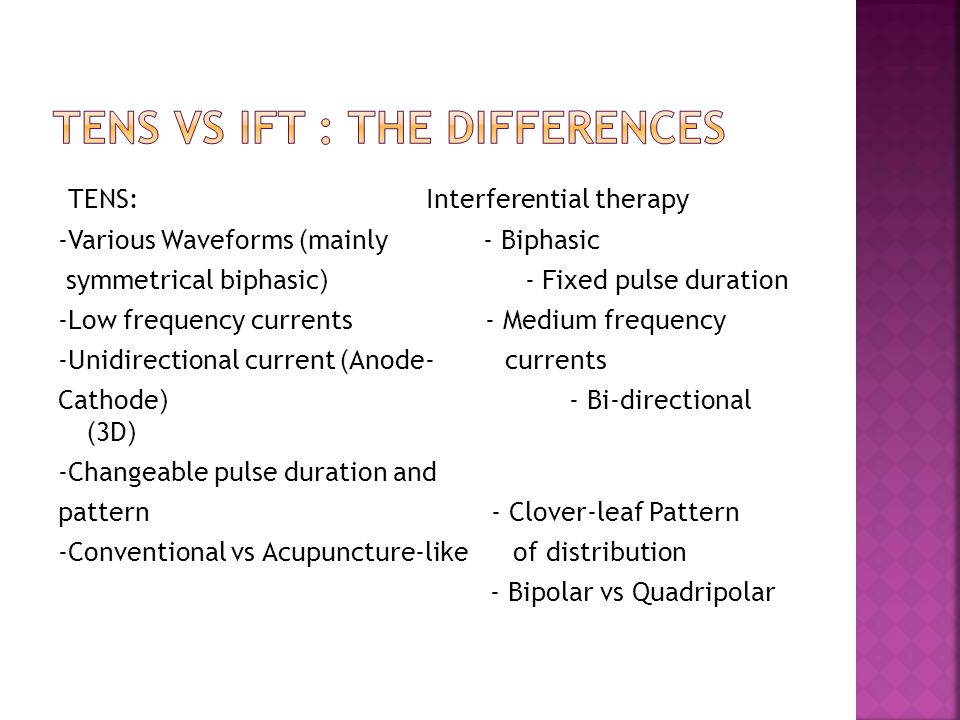
TENS literally stands for Transcutaneous Electrical Nerve Stimulation and IFT is an abbreviation for Inferential Current Therapy. Both are palliative treatments that utilize electric currents for long-term intractable pain and post-operative and post-traumatic periods of acute pain. The two procedures were proven harmless and effective substitutes for pharmacologic treatments to control pain. Equally, they have a minimal side effects on patients and are non-addictive. They can cause some adverse effects by the irritations of the skin where the electrodes are placed. They are both convenient to use and easy to carry.
However, there are evident differences between TENS and IFT. IFT uses a two-polar frequency circuit and a four-polar frequency circuit of slightly dissimilar cycles per second that are placed on the site that will give you the resultant frequency that is conceded by the specific frequency amplitude. Then an interference is formed that can block the pain transmission messages at the level of the spinal cord. The stimulation of the inferential electricity can concentrate at the intersection point of the electrodes through the location of the deep tissues. On the other hand, TENS stimulates the generation of a current that can flow through its leads to electrodes that are placed in specific locations on the person’s skin.
TENS electric reactions in the sensory and motor nerve fibers are caused by the low-voltage current. It uses the gate control theory. The theory states that if a pain message has already stimulated the nerve fibers of the spinal cord, at that moment the gate closes which inhibits the occurrence of another pain message.
While for the IFT, the focus of its function is to block the pain message on the peripheral nerve fibers. TENS modulates low frequency (125Hz) versus the IFT which usually delivers at 4000Hz. The IFT can deliver electric currents with much more comfort than a TENS unit.
It is also proven that IFT can reach greater depths and offers electrotherapy to a larger number of tissues than TENS. Typically, pain with a very deep origin is hard to reach with other treatment modalities other than IFT. IFT stimulates circulation, and TENS can stimulate endorphin production. TENS can only treat conditions with low-risk involvement like treating back pain. It is contraindicated for pregnant women.
IFT is used to manage edema, pain, and inflammation which are caused by trauma or degenerative alterations with the involvement of soft tissues. It can treat conditions like shingles, neuralgia, and osteoarthritis. In addition, studies claim that IFC has a role in stimulating the healing and restoration of tissues while TENS only focuses on controlling pain.
The two procedures can be used during labor to control pain. It is proven to be effective and safe. Patients with pacemakers should also be warned about using it. It can be administered on a controlled condition with careful application to ensure the safety of the patient. Patients should also be assessed for any allergies to gels, electrodes, and tapes. The health team member should not put the electrodes on top of dermatologic lesions such as eczema and dermatitis.
SUMMARY
- IFT uses the stimulation of the inferential electricity that concentrates at the intersection point of the electrodes while TENS stimulates the generation of current that can flow through its leads to electrodes that are placed on specific locations on the person’s skin.
- IFT focuses its function primarily on blocking the pain message on the peripheral nerve fibers. On the other hand, a TENS unit’s electric reactions are for the sensory and motor nerve fibers.
- IFT usually delivers at 4000Hz versus TENS which modulates at a low frequency of 125Hz.
- IFT can deliver electric currents with much more comfort than a TENS unit.
- IFT can reach greater depths and offers electrotherapy to a larger number of tissues than TENS.
- IFT stimulates circulation, and TENS can stimulate endorphin production.
- IFT is used to manage edema, pain, and inflammation which are caused by trauma or degenerative alterations with the involvement of soft tissues while TENS can only treat conditions with low risk involved like back pains. It is contraindicated for pregnant women.
- IFT has a role in stimulating healing and restoration of tissues while TENS only focuses on controlling pain.

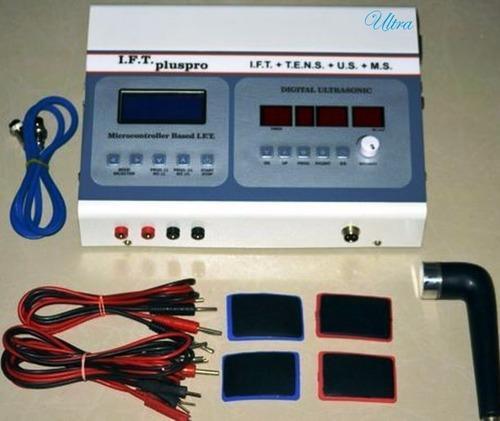




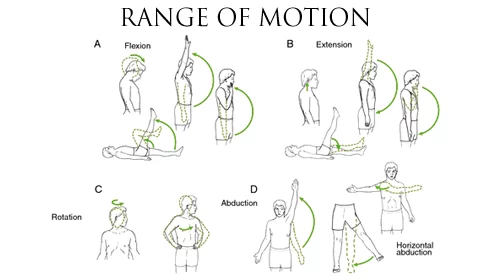

I am 82 & on ther basis of my MRI LUMBOSACRAL SPINE (3 TESLA)11Th Jan I am diagnosed with NEURAL CANAL STENOSIS
On 11th I was advised Physiotherapy comrising of
IFT -10SITTINGS , INTERMITTENT LUMBAR TRACTION ,SPINAL FLEXION / EXTENSION EXCERCISES
During review on 27th I am advised
IFT -10SITTINGS
TENS
SPINAL FLEXION EXCERCISES
My query is that on 28th I was given only TENS & told it is same as IFT but location is accordingly
I am not satisfied with it as Dr as seperatly mentioned IFT & TENS
PL. CLARIFY
S.P.JAIN -82+
Tens and ift are not same… they are totally different in the view of their mechanism of action… but for layman person it is same so sometimes the physio doctor to save their time tells the pt that both are same so tell doctor
Very useful Article , I Personally Prefer IFT for treatment of Radiating Pain, TENS i uses mostly in Home Visit, Now I fully Understand Differences of Both Modalities, Thanks for Updating.